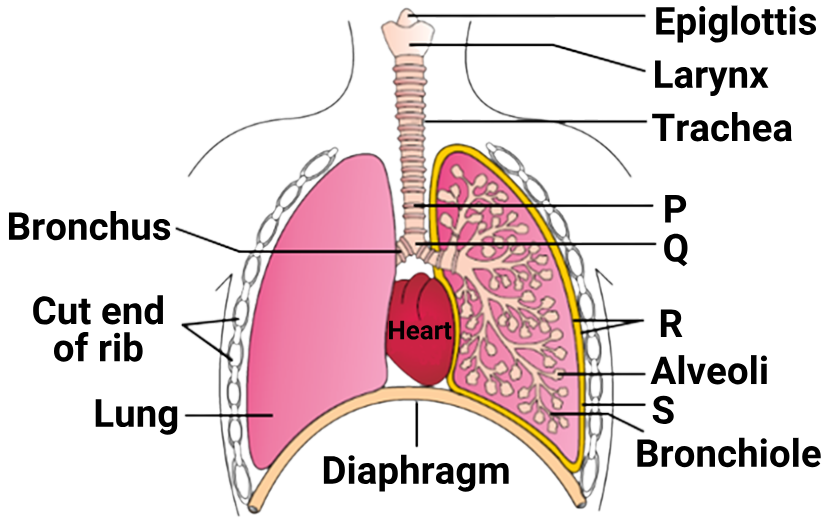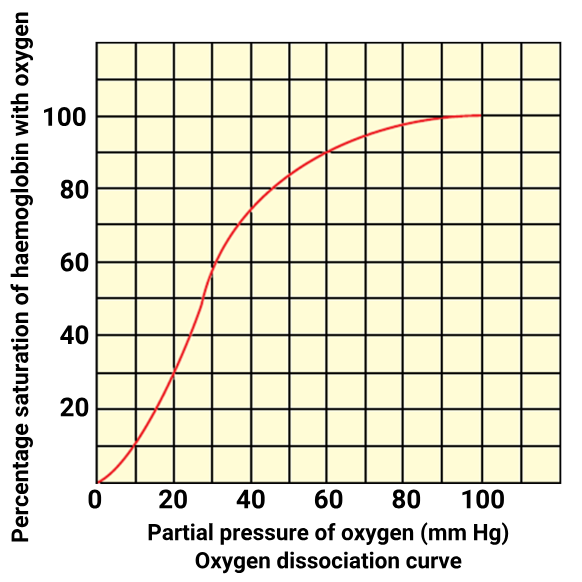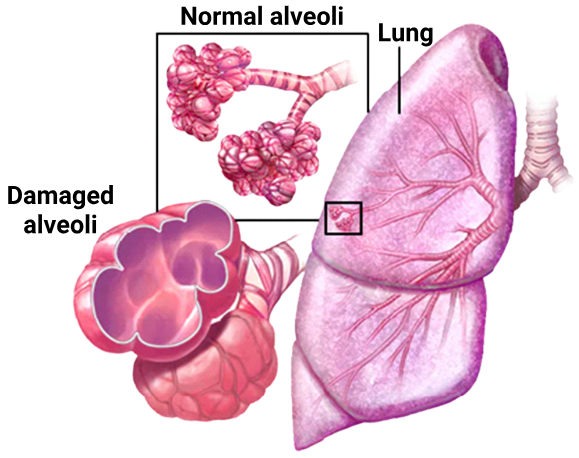Breathing and Exchange of Gases NCERT
Quiz Summary
0 of 45 Questions completed
Questions:
Information
You have already completed the quiz before. Hence you can not start it again.
Quiz is loading…
You must sign in or sign up to start the quiz.
You must first complete the following:
Results
Results
0 of 45 Questions answered correctly
Your time:
Time has elapsed
You have reached 0 of 0 point(s), (0)
Earned Point(s): 0 of 0, (0)
0 Essay(s) Pending (Possible Point(s): 0)
Categories
- Not categorized 0%
- 1
- 2
- 3
- 4
- 5
- 6
- 7
- 8
- 9
- 10
- 11
- 12
- 13
- 14
- 15
- 16
- 17
- 18
- 19
- 20
- 21
- 22
- 23
- 24
- 25
- 26
- 27
- 28
- 29
- 30
- 31
- 32
- 33
- 34
- 35
- 36
- 37
- 38
- 39
- 40
- 41
- 42
- 43
- 44
- 45
- Current
- Review
- Answered
- Correct
- Incorrect
-
Question 1 of 45
1. Question
1 point(s)Name the cavities in which the lungs are located:
CorrectIncorrectHint
(d)
-
Question 2 of 45
2. Question
1 point(s)A minimal amount of pleural fluid present in the pleural cavity:
CorrectIncorrectHint
(b)
-
Question 3 of 45
3. Question
1 point(s)Branchial respiration is seen in all the following except:
CorrectIncorrectHint
(c)
However, amphibians like frogs primarily rely on lungs and their moist skin for respiration. While frog larvae (tadpoles) possess gills and utilize branchial respiration, adult frogs do not. Instead, they breathe through their lungs and skin—a process known as cutaneous respiration.
-
Question 4 of 45
4. Question
1 point(s)The conducting part of the human respiratory system is not involved in:
I. Clearing inhaled air from foreign particles
II. Humidifying the exhaled air
III. Bringing the air to a temperature higher than body temperatureCorrectIncorrectHint
(b)
-
Statement II: “Humidifying the exhaled air” is not a primary function of the conducting zone. While some moisture is reclaimed during exhalation, the main humidification occurs during inhalation.
-
Statement III: “Bringing the air to a temperature higher than body temperature” is incorrect. The conducting zone warms inhaled air to body temperature but does not increase it beyond that
-
Question 5 of 45
5. Question
1 point(s)Incomplete cartilaginous rings are seen in the walls of all the following except:
CorrectIncorrectHint
(d)
-
Question 6 of 45
6. Question
1 point(s)The given figure shows the diagrammatic view of human respiratory system (sectional view of the left lung is also shown). Regarding the parts labelled as P , Q , R and S , which of the following statements are true?

I: P is an incomplete cartilaginous ring seen only in trachea and principal bronchus.
II: Q is the point where the trachea divides into a right and left primary bronchus and corresponds to the level of 5th thoracic vertebra.
III: R shows the double-layered pleura where the outer pleural membrane is in close contact with the thoracic lining.
IV: S is pleural cavity with minimal amount of pleural fluid which reduces friction on the lung surface.CorrectIncorrectHint
(c)
Statement I is incorrect
-
P is the trachea: ✔️ has incomplete cartilage rings.
However, the claim that these rings are “only” found in trachea and principal bronchi is incorrect, because cartilage structures (though not always C-shaped) are seen further along in the bronchial tree
-
Question 7 of 45
7. Question
1 point(s)Consider the following two statements:
I. The lungs are situated in the thoracic chamber which is anatomically an air-tight chamber.
II. This arrangement is essential as we cannot directly alter the thoracic volume.CorrectIncorrectHint
(c)
Statement II:
“This arrangement is essential as we cannot directly alter the thoracic volume.”
❌ Incorrect-
We can directly alter thoracic volume through:
-
Diaphragm contraction (moves downward during inspiration)
-
Intercostal muscle contraction (expands rib cage)
-
-
These actions increase the volume of the thoracic cavity, thereby reducing intrathoracic pressure and drawing air into the lungs.
-
Question 8 of 45
8. Question
1 point(s)Consider the given two statements:
I: Lower invertebrates like sponges, coelenterates and flatworms exchange oxygen with carbon dioxide by simple diffusion over their entire body surface.
II: Fishes are the only vertebrates that do not use lungs as respiratory organs.CorrectIncorrectHint
(c)
-
Question 9 of 45
9. Question
1 point(s)It is necessary that lungs must be present in anatomically air-tight chamber because:
CorrectIncorrectHint
(a)
-
Question 10 of 45
10. Question
1 point(s)Which of the following is not correctly matched ?
\(
\begin{array}{|l|l|l|}
\hline \hline \text { I. } & \begin{array}{l}
\text { Thoracic chamber is formed dorsally } \\
\text { by }
\end{array} & \text { Sternum } \\
\hline \text { II. } & \begin{array}{l}
\text { Thoracic chamber is formed ventrally } \\
\text { by }
\end{array} & \begin{array}{l}
\text { Vertebral } \\
\text { column }
\end{array} \\
\hline \text { III. } & \begin{array}{l}
\text { Thoracic chamber is formed laterally } \\
\text { by }
\end{array} & \text { Ribs } \\
\hline \text { IV. } & \begin{array}{l}
\text { Thoracic chamber is formed on the } \\
\text { lower side by }
\end{array} & \text { Diaphragm } \\
\hline
\end{array}
\)CorrectIncorrectHint
(a)
Thoracic chamber is formed dorsally by vertebral column
Thoracic chamber is formed ventrally by sternum
-
Question 11 of 45
11. Question
1 point(s)The figure shows the events happening during the inhalation and exhalation phases of pulmonary ventilation. Read the two given statements carefully.

I:- A shows the inhalation phase brought about by the contraction of diaphragm that increases the volume of thorax in antero-posterior axis and by the contraction of external intercostal muscle that increases the volume of thorax in dorso-ventral axis.
II:- B shows the exhalation phase brought about by the relaxation of diaphragm that decreases the volume of thorax in antero-posterior axis and by the contraction of internal intercostal muscle that decreases the volume of thorax in dorso-ventral axis.CorrectIncorrectHint
(d)
-
Diaphragm contraction increases volume in the vertical (superior-inferior) direction, not antero-posterior.
-
External intercostals lift the ribs up and outward, increasing antero-posterior and transverse (side-to-side) diameters — not “dorso-ventral”.
⛔ So, Statement I is incorrect due to wrong axis terms.
-
Diaphragm relaxation indeed causes upward movement and decreases vertical thoracic volume — not antero-posterior.
-
Internal intercostals, when they contract (during forced expiration), pull the ribs down and in, which decreases antero-posterior and transverse dimensions — not dorso-ventral.
⛔ So, Statement II is also incorrect for misidentifying axis of volume change.
-
Question 12 of 45
12. Question
1 point(s)Regarding pulmonary capacities, the maximum volume of air a person can breathe in after a forced expiration can also be defined as:
CorrectIncorrectHint
(c)
-
Question 13 of 45
13. Question
1 point(s)In inspiration during pulmonary ventilation the correct order of the given events is:
a. air flows into the lungs
b. alveolar volume increases
c. thoracic volume increases
d. pleural pressure decreases
e. alveolar pressure decreasesCorrectIncorrectHint
(c)
-
Question 14 of 45
14. Question
1 point(s)Consider the given two statements:
I: Relaxation of the diaphragm and the intercostal muscles causes the expulsion of air from the lungs.
II: Relaxation of the diaphragm and the intercostal muscles increases the volume of thoracic chamber in the antero-posterior axis.CorrectIncorrectHint
(c)
Statement II is incorrect
-
Relaxation of the diaphragm causes it to move upward, and intercostals allow the ribs to move down and inward, which decreases thoracic volume — not increases.
-
Also, relaxation reduces the antero-posterior and transverse diameters of the thorax.
-
Question 15 of 45
15. Question
1 point(s)Both carbon dioxide and oxygen move across the respiratory membrane due to:
CorrectIncorrectHint
(c)
-
Question 16 of 45
16. Question
1 point(s)With respect to the atmospheric air, the deoxygenated blood flowing into lung capillaries has a higher concentration of:
CorrectIncorrectHint
(d)
-
Question 17 of 45
17. Question
1 point(s)Exchange of gases occurs across the respiratory membrane. Which of the following would increase the rate of diffusion of a gas across the respiratory membrane?
CorrectIncorrectHint
(c)
-
Question 18 of 45
18. Question
1 point(s)When compared with carbon dioxide, the partial pressure of oxygen in the air and its solubility in water is respectively:
CorrectIncorrectHint
(c)
-
Question 19 of 45
19. Question
1 point(s)The value of partial pressure of oxygen in alveolar air is:
CorrectIncorrectHint
(d)
-
Question 20 of 45
20. Question
1 point(s)Carbon dioxide is transported in blood by all the following mechanisms except:
CorrectIncorrectHint
(b)
Do not bound with Fe
-
Question 21 of 45
21. Question
1 point(s)

I: The partial pressures of Oxygen and Carbon dioxide at Point A in Figure I correspond to that of Point P in Figure II.
II: The partial pressure of Carbon dioxide at Point B in Figure I corresponds to that of Point Q in Figure II.
CorrectIncorrectHint
(c)
-
Question 22 of 45
22. Question
1 point(s)Identify the incorrect statement regarding the enzyme carbonic anhydrase:
CorrectIncorrectHint
(b)
-
Question 23 of 45
23. Question
1 point(s)The binding of carbon dioxide to hemoglobin:
I. is related to the partial pressure of carbon dioxide
II. is affected by the partial pressure of oxygenCorrectIncorrectHint
(c)
-
Question 24 of 45
24. Question
1 point(s)The major mode of transport of carbon dioxide in human body is:
CorrectIncorrectHint
(d)
-
Question 25 of 45
25. Question
1 point(s)Which of the following is higher in value?
CorrectIncorrectHint
(c)
-
Question 26 of 45
26. Question
1 point(s)Study the oxygen-haemoglobin dissociation curve given in the figure and select the correct statements regarding it:

Study the oxygen-haemoglobin dissociation curve given in the figure and select the correct statements regarding it:
I: The p50 is the pressure at which haemoglobin is \( 50 \% \) saturated which corresponds to about 27 mmHg on the Xaxis.
II: A right shift of the curve means haemoglobin holds less tightly onto oxygen and delivers more oxygen to the tissues at a given arterial oxygen pressure.CorrectIncorrectHint
(c)
-
Question 27 of 45
27. Question
1 point(s)The duration of inspiration can be reduced by:
CorrectIncorrectHint
(c)
-
Question 28 of 45
28. Question
1 point(s)A condition in which a person’s airways become inflamed, narrow, swell and produce extra mucus, which makes it difficult to breathe is known as
CorrectIncorrectHint
(a)
-
Question 29 of 45
29. Question
1 point(s)Pulmonary fibrosis is a pathological hallmark of:
CorrectIncorrectHint
(d)
-
Question 30 of 45
30. Question
1 point(s)Which of the following is incorrect regarding emphysema?
CorrectIncorrectHint
(b)
There is an decrease in the respiratory surface
-
Question 31 of 45
31. Question
1 point(s)Study the given figure showing the neural regulation of respiration in humans and select the correct statements from the given statements.

Statement I: The location of the pneumotaxic centre is the Pons of the brain stem and it moderates the function of respiratory rhythm centre.
Statement II: The respiratory rhythm centre is the dorsal respiratory group shown in the figure and is also located in the Pons of the brain stem.CorrectIncorrectHint
(a)
Statement II:
“The respiratory rhythm centre is the dorsal respiratory group shown in the figure and is also located in the Pons of the brain stem.”
❌ False-
The respiratory rhythm centre primarily includes the dorsal and ventral respiratory groups, which are located in the medulla oblongata, not the pons.
-
So, the location is incorrectly stated in this statement.
-
Question 32 of 45
32. Question
1 point(s)Assertion: Oxidized hemoglobin carries maximum oxygen in the human blood.
Reason: Oxidized hemoglobin has more affinity for oxygen than deoxygenated hemoglobin.CorrectIncorrectHint
(d)
Assertion:
“Oxidized hemoglobin carries maximum oxygen in the human blood.”
🔴 False
-
The term oxidized hemoglobin typically refers to methemoglobin (MetHb), not oxyhemoglobin.
-
Methemoglobin contains iron in the Fe³⁺ (ferric) state instead of the normal Fe²⁺ (ferrous) state.
-
Fe³⁺ cannot bind oxygen, so oxidized hemoglobin (methemoglobin) does NOT carry oxygen, let alone the maximum amount.
Reason:
“Oxidized hemoglobin has more affinity for oxygen than deoxygenated hemoglobin.”
🔴 False
-
Again, if we correctly interpret oxidized hemoglobin as methemoglobin, it has no affinity for oxygen because Fe³⁺ cannot bind O₂.
-
Therefore, it has less, not more, affinity than deoxygenated hemoglobin.
-
Question 33 of 45
33. Question
1 point(s)Identify the respiratory disorder shown in the figure above:
 CorrectIncorrect
CorrectIncorrectHint
(b)
-
Question 34 of 45
34. Question
1 point(s)What is true about RBCs in humans?
CorrectIncorrectHint
(a)
-
Question 35 of 45
35. Question
1 point(s)Oxygen binding to haemoglobin in blood is
CorrectIncorrectHint
(b)
-
Question 36 of 45
36. Question
1 point(s)Identify the wrong statement with reference to the transport of oxygen.
CorrectIncorrectHint
(b)
Higher H+ concentration actually inhibits the formation of oxyhaemoglobin. This is because a higher H+ concentration leads to a more acidic environment, which causes the oxygen-hemoglobin affinity to decrease. Therefore, in the alveoli where the goal is to load oxygen onto haemoglobin, a low H+ concentration is favorable.
-
Question 37 of 45
37. Question
1 point(s)Why would hemoglobin deliver oxygen to the tissues?
CorrectIncorrectHint
(a)
-
Question 38 of 45
38. Question
1 point(s)The respiratory system does not:
CorrectIncorrectHint
(b)
-
Question 39 of 45
39. Question
1 point(s)The diffusion of gases in lungs occur across the respiratory membrane. Which of the following is incorrect regarding the respiratory membrane?
CorrectIncorrectHint
(c)
Explanation: Oxygen does diffuse passively across the respiratory membrane from the alveolar air into the capillary blood, meaning it moves due to a concentration gradient without the need for active transport. -
Question 40 of 45
40. Question
1 point(s)Oxygenated blood through the tissues of the lungs is carried by:
CorrectIncorrectHint
(c)
-
Question 41 of 45
41. Question
1 point(s)Match the following columns and select the correct option :
\(
\begin{array}{|l|l|l|l|}
\hline & \text { Column I } & & \text { Column II } \\
\hline \text { (a) } & \text { Pneumotaxic centre } & \text { (i) } & \text { Alveoli } \\
\hline \text { (b) } & \mathrm{O}_2 \text { dissociation curve } & \text { (ii) } & \begin{array}{l}
\text { Pons region of the } \\
\text { brain }
\end{array} \\
\hline \text { (c) } & \text { Carbonic anhydrase } & \text { (iii) } & \text { Haemoglobin } \\
\hline \text { (d) } & \begin{array}{l}
\text { Primary site of exchange of } \\
\text { gases }
\end{array} & \text { (iv) } & \text { R.B.C. } \\
\hline
\end{array}
\)Options:-
\(
\begin{array}{|l|l|l|l|l|}
\hline & \text { (a) } & \text { (b) } & \text { (c) } & \text { (d) } \\
\hline 1 . & \text { (i) } & \text { (iii) } & \text { (ii) } & \text { (iv) } \\
\hline 2 . & \text { (ii) } & \text { (iii) } & \text { (iv) } & \text { (i) } \\
\hline 3 . & \text { (iii) } & \text { (ii) } & \text { (iv) } & \text { (i) } \\
\hline 4 . & \text { (iv) } & \text { (i) } & \text { (iii) } & \text { (ii) } \\
\hline
\end{array}
\)CorrectIncorrectHint
(b)
-
Question 42 of 45
42. Question
1 point(s)The pulmonary function of a person reveals the following values:
a. tidal volume = 500 mL
b. residual volume = 1000 mL
c. inspiratory reserve volume = 2500 mL
d. expiratory reserve volume = 1000 mL.His Vital Capacity:
CorrectIncorrectHint
(c)
IRV + ERV + TV
-
Question 43 of 45
43. Question
1 point(s)Consider the following statements:
I. The thoracic chamber is anatomically an air tight chamber.
II. Any change in the volume of the thoracic cavity will be reflected in the pulmonary cavity.CorrectIncorrectHint
(b)
-
Question 44 of 45
44. Question
1 point(s)Lungs do not collapse between breaths and some air always remains in the lungs which can never be expelled because
CorrectIncorrectHint
(b)
-
Question 45 of 45
45. Question
1 point(s)From the following statements select the correct option/s
(a) Gills are special vascularized structures used by most of the aquatic animals
(b) Lungs are used by the terrestrial forms for the exchange of gases.
(c) Frogs can respire through their moist skin.
(d) Sound box in human is made up of cartilages & bonesCorrectIncorrectHint
(a)
The human voice box, or larynx, is primarily made of cartilage and not bone. While it does have some supporting structures like the hyoid bone, the laryngeal skeleton itself is composed entirely of cartilages. The statement that it’s made of bone is incorrect